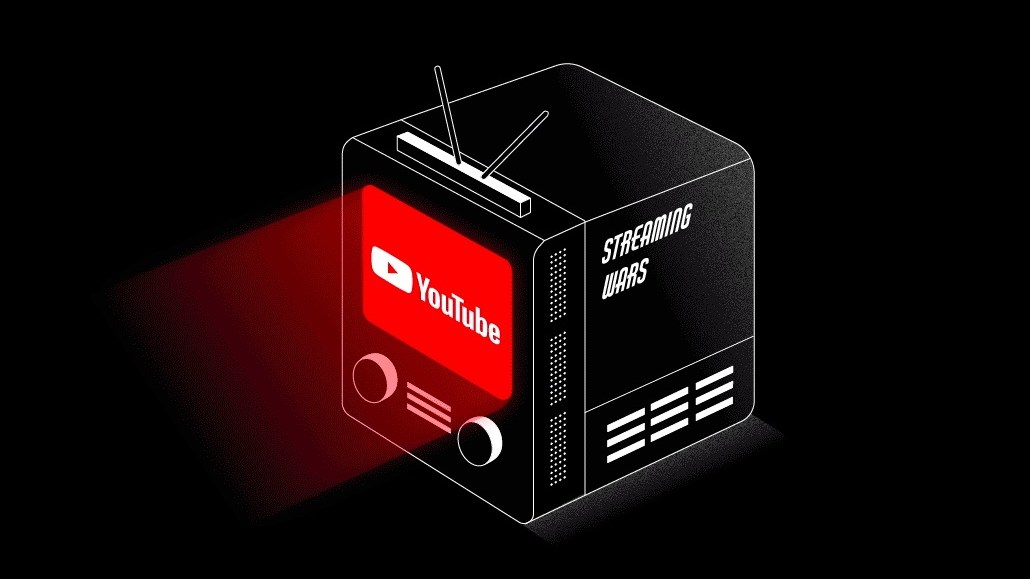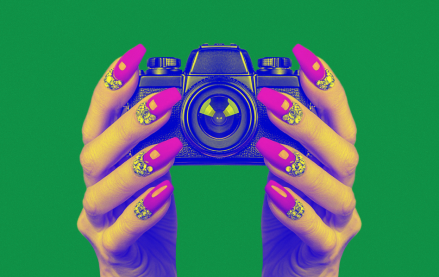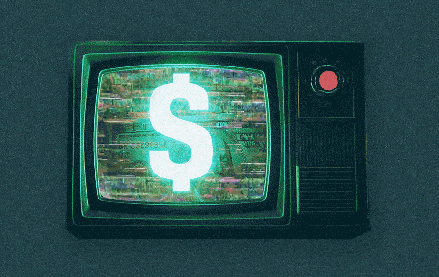Save 50% on a 3-month Digiday+ membership. Ends Dec 5.
Future of TV Briefing: TV is YouTube’s top screen — except when counting views and among Gen Z viewers

This Future of TV Briefing covers the latest in streaming and TV for Digiday+ members and is distributed over email every Wednesday at 10 a.m. ET. More from the series →
This week’s Future of TV Briefing looks at how mobile still accounts for an overwhelming majority of YouTube video views and why some Gen Z viewers aren’t tuning into YouTube on TV screens.
- Screen check
- Let’s talk CTV in NYC
- YouTube vs. TikTok vs. Instagram: What Gen Z really watches in 2025
- Brands on the big screen, TikTok & Instagram on TV screens and more
Screen check
This year marked a milestone for YouTube. People are spending more time watching the platform’s videos on TV screens than any other device. But there’s a but. Actually two buts.
While TV has taken the top spot in terms of time spent on YouTube, mobile remains the main screen when it comes to view counts. And Gen Z viewers seem to prefer to watch YouTube from their phones, tablets and laptops.
Of the 15 teens and twentysomethings I spoke to last month during VidCon – the annual creator economy event that took place in Anaheim, Calif. – only one said they watch YouTube on TV screens, despite most citing YouTube as the video app they use the most.
More than two-thirds – 69% – of YouTube video views are taking place on mobile devices, compared to 16% of views that are happening on TV screens, according to research presented by video analytics firm Tubular Labs in a VidCon session on June 20.
“In terms of raw views, we are still primarily watching the highest number of videos on our mobile devices,” said Tubular CMO Jill Nicholson. She noted that, despite mobile accounting for the majority of YouTube video view counts, CTV does represent the largest share of minutes watched at 42%.
But you probably already knew that. So let’s talk about the primacy of mobile when it comes to view counts.
YouTube Shorts appear to be the primary reason that people are watching more videos on phones and tablets than TVs. In fact, 88% of YouTube views so far this year went to Shorts, and 57% of all videos uploaded to YouTube in 2025 by U.S. creators have been Shorts, per Tubular Labs.
And it’s not just the volume of mobile-friendly, short-form videos being uploaded to YouTube. People are also typically watching YouTube for at least 20 minutes at a time. That’s definitely true on TV – and explains why TV leads in share of watch time – but people are also spending 20 minutes at a time watching YouTube on mobile. They’re just watching many more videos on mobile than on TV.
“While individual video views on mobile may be short form, there’s many more videos per session, which is what’s going to give us that 20 minute-plus watch time,” Nicholson said.
Honestly, Tubular’s research didn’t exactly shock me. But that’s probably only because, by the time I sat in on the session, I had already talked to more than a half-dozen Gen Z attendees who said they prefer to watch YouTube on their mobile devices and computers. Hearing them say that did surprise me, so I asked them why. Here’s what they had to say.
Let’s start with 18-year-old Dawn who was the only attendee I spoke to who does watch YouTube on a TV screen. But there’s an asterisk on that answer. Initially they said they don’t watch YouTube on a TV screen before catching themselves on a technicality: “But I guess kind of because I have a TV as my second monitor.”
“It’s just easier to carry around and, you know, go places,” said 14-year-old Milo, who cited their phone as their preferred device for watching YouTube.
“It’s just convenient while I play games,” said Nicholas, a 17-year-old who prefers to watch YouTube on their computer.
“I mostly watch long-form content mostly on my computer, but I mostly watch short-form content on my phone,” said 15-year-old John.
Convenience isn’t the only reason that kids aren’t tuning into YouTube as much on TV screens, though.
For 15-year-old Hadley, the fact is that a lot of the videos they watch “aren’t very family-friendly. So yeah, it’s kind of awkward to watch with your family.”
Meanwhile, for 17-year-old Lucy, “my other family members are using the TV more than me, so I just don’t use it that much.”
What we’ve heard
“Instagram Reels is hell on earth.”
— Aiden, a 17-year-old VidCon attendee
Let’s talk CTV in NYC
Are you tired of talking about CTV advertising? No? Me neither. Which is why I’m psyched to bring together a bunch of my favorite buy-side executives to talk about the state of the CTV ad market next month in New York City for the Digiday CTV Advertising Strategies event on July 15 (I’m less stoked about leaving southern California in mid-July for hot and humid NYC, but that’s another thing).
Anyway, come hang out and hear how top executives from brands and agencies — including Amica Insurance, Danone, Horizon Media and UM Worldwide — are navigating the opportunities and challenges in today’s CTV ad market and what they say it will take for streaming to overtake the TV once and for all. Plus we’ll be hosting a behind-closed-doors, no-holds-barred town hall session, which is always my favorite part of Digiday events. Click here to attend.
Numbers to know
5.6 million: Average number of additional subscribers that streaming services receive from selling subscriptions through Amazon’s Prime Video Channels.
24.3%: Percentage decline in the number of Writers Guild of America West members who reported making money in 2024 compared to pre-strike 2022.
$20: Monthly price for a subscription to DirecTV’s “MyKids” streaming pay-TV package of kids-oriented TV networks.
YouTube vs. TikTok vs. Instagram: What Gen Z really watches in 2025
Every year, while many of you are in the south of France, I go to Anaheim, Calif., for VidCon — the creator economy’s Comic-Con and a forum for me to ask teens and twentysomethings for their takes on today’s video platforms. Here’s what they had to say this time.
What we’ve covered
TikTok pushes deeper into AI-powered ads amid uncertainty over U.S. ban:
- During Cannes Lions meetings, TikTok talked up its Smart+ platform.
- The video platform also highlighted an audience suggestion tool that’s in testing.
Read more about TikTok here.
WTF is behind the explosion of faceless creators?:
- The number of faceless creators in AffiliateNetwork.com’s network has increased from 5,000 to 21,000 in the past three months (which sounds like a red flag in the AI era and the creator version of MFA sites, but I digress).
- Publicis and Dentsu executives said their clients are spending more money on sponsorship deals with faceless creators.
Read more about faceless creators here.
Brand deals surge for golf creators as the sport’s popularity spikes:
- Mountain Dew has been sponsoring golf creators in the past year.
- Creator sponsorships can be cheaper than the $15 million to $25 million price tag for sponsoring golf tournaments, though tournament organizers can limit creators’ content.
Read more about golf creators here.
As social platforms favor creators, publishers are left out of the referral loop:
- Social and video platforms have overtaken TV news networks and digital news sites as the main sources of news for people in the U.S.
- In response, news publishers are putting more journalists in front of cameras and microphones.
Read more about publishers’ news influencer reckoning here.
What we’re reading
Branded entertainment on the big screen:
TV shows and movies are working more closely with brands to place products in programs and have advertiser help subsidize productions, according to The Wall Street Journal.
TikTok & Instagram eye the TV screen:
The mobile video platforms are looking replicate YouTube’s success by expanding to connected TV (though TikTok has already tried and failed to make inroads in CTV and Instagram may be hoping folks have forgotten about IGTV), according to The Information.
YouTube has started rolling out its version of Google’s AI overviews, which will show summaries of relevant videos in response to people’s searches on the video platform, according to TechCrunch.
MrBeast’s AI thumbnail thumbs-down:
YouTube’s top creator has shut down his AI thumbnail generator that launched a couple weeks ago and was immediately criticized for allowing people to use generative AI to replicate other creators’ thumbnails, according to Business Insider.
Paramount nears settlement with Trump:
CBS’s parent company is looking to settle the U.S. president’s lawsuit over the “60 Minutes” interview with Vice President Kamala Harris ahead of last year’s election in hopes of getting the greenlight for Paramount’s sale to Skydance, according to The New York Times.
Want to discuss this with our editors and members? Join here, or log in if you're already a member.
More in Future of TV

Future of TV Briefing: The creator economy needs a new currency for brand deals
This week’s Future of TV Briefing looks at why paying creators based on reach misses the mark and what IAB is doing to clear up the creator-brand currency situation.

Future of TV Briefing: WTF is IAB Tech Lab’s device attestation tactic to combat CTV ad fraud?
This week’s Future of TV Briefing breaks down the CTV ad industry’s new tool for fighting device spoofing.

Future of TV Briefing: Streaming subscribers save $16 through bundles
This week’s Future of TV Briefing looks at how much money people are actually signing through streaming subscription bundles and which streamers they plan to subscribe to in perpetuity.








